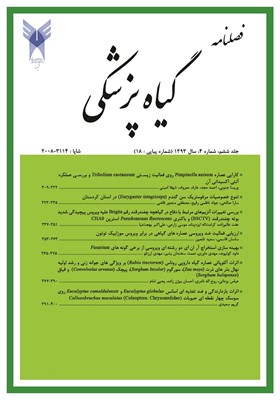اثرات آللوپاتی عصاره گیاه دارویی روناس(Rubia tinctorum) بر ویژگی های جوانه زنی و رشد اولیه نهال بذر های ذرت (Zea mays)، سورگوم(Sorghum bicolor )، پیچک (Convolvolus arvense) و قیاق (Sorghum halepense)
الموضوعات : Plant Protectionروح اله نادری 1 , عباس یزدانی 2 , یحیی امام 3 , احسان بیژن زاده 4
1 -
2 -
3 -
4 -
الکلمات المفتاحية: Sorghum, corn, سورگوم, آللوپاتی, Allelopathy, ذرت, Medicinal plant madder, Field bindweed, Johnson grass, روناس, پیچک و قیاق,
ملخص المقالة :
به منظور بررسی اثرات آللوپاتیک عصاره گیاه روناس بر خصوصیات جوانهزنی چند گیاه زراعی و علف هرز، 4 آزمایش جداگانه اجرا شد.آزمایشها در قالب طرح کاملاً تصادفی با 4 تکرار و 5 تیمار بود. تیمارها شامل غلظتهای مختلف عصاره روناس در 5 سطح (صفر، 25%، 50%، 75% و 100%) و بذرهای گیاهان زراعی و علف های هرز (ذرت ، سورگوم، پیچک و قیاق) بودند. نتایج نشان داد که عصاره روناس ویژگیهای جوانهزنی مانند، درصد و سرعت جوانهزنی، طول ریشهچه و ساقه چه، نسبت طول ریشهچه به ساقه چه (R/S)، شاخص بنیه گیاهچه و وزن خشک کل همگی گیاهان را بهطور معنیداری کاهش داد (p<0.5). درصد جوانه زنی بذرهای ذرت تا غلظت 50% عصاره و بذرهای سورگوم تا غلظت 75% عصاره تحت تاثیر قرار نگرفتند و تفاوت معنی داری با شاهد نداشتند، در صورتی که درصد جوانه زنی در بذر علف های هرز حتی با عصاره 25% روناس کاهش شدیدی نشان دادند. به طور کلی در غلظت 25% ، جوانه زنی پیچک و قیاق به ترتیب %97 و %5/95 نسبت به ذرت و %96 و %94 کاهش نسبت به سورگوم نشان دادند. افزایش غلظت عصاره باعث کاهش معنی دار در سرعت جوانه زنی، طول ریشه چه و ساقه چه، نسبت ریشه به ساقه، شاخص بنیه گیاهچه و وزن خشک کل بذرهای گیاهان و علف های هرز شد. اما اثر بازدارندگی در بذر علف های هرز شدیدتر از گیاهان زراعی بود. نتایج نشان دهنده این است که روناس به عنوان یک گیاه دارویی سودمند ممکن است دارای ترکیبات شیمیایی آللوپاتیکی باشد که می تواند رشد گیاهچه علف های هرز قیاق و پیچک را در مزارع ذرت و سورگوم سرکوب نماید.
Fernandez-Aparicio, M., Emeran, A. A., & Rubiales, D. 2008. Control of Orobanche crenata in legumes intercropped with fenugreek (Trigonella foenum-graecum). Crop Protection, 27: 653–659.
Formanek ,I., & Racz, G. 1975. The antibiotic effect of the madder root (Rubia tinctorium). Pharmazie. 30(9): 617.
Fuji, Y., Furukawa, M., Hayakawara, Y., Sugawara, K. & Shibuya, T. 1991. Survey of Japanese medicinal plants for the detection of allelopathic properties. Weed Research, 36: 36-42.
Iqbal, J., & Wright, D. 1999. Effect of weed competition on flag leaf photosynthesis and grain yield of spring wheat. Agriculture Science, 123: 23-30.
Kato-Noguchi, H. 2003. Assessment of allelopathic potential of shoot powder of lemon balm. Scientia Horticulturae (Amsterdam), 97: 419-423.
Makkizadeh, M, Salimi, M. & Farhoudi, R. 2009. Allelopathic effect of rue (Ruta graveolens L.) on seed germination of three weeds. Iranian Journal of Medicinal and Aromatic Plants, 24,363-471.
Martin, V. L. , McCoy, E.L., & Diek, W. A. 1990. Allelopathy of crop residues influences corn seed germination and early growth. Agronomy Journal, 82:555-560.
Musa nejad, V. & Mirshekari, B. 2008. Allelopathic effect of essence of fennel, cumin and dill weed germination and seedling establishment of pigweed, filed bindweed and nutsedge in greenhouse and laboratory experiment. 18th Iranian Congress of Plant Protection, Iran. P40.
Najafi Ashtiani, A. Assareh, M. H., Baghestani,M.A.&Angaji,S.J. 2008. The Effects of methanolic extract of Eucalyptus camaldulensis Dehnh. on growth and germination rates of Chenopodium album L. Iranian Journal of Medicinal and Aromatic Plants, 24, 293-303.
Rashed mohassel, M. H., Azizi, G., Alimoradi, L., Gharokhlu, J. 2005.Allopathic effect of saffron leaf and Stinking assa on germination of pigweed. 1st National congress of Weeds science. Tehran, Iran.
Samadani, B. & Baghestani, M. 2005. Allelopathic effect of different species of Thyme on seed germination and growth of wild oat. Pajuhesh & Sazandegi. 68. 69-84.
Sandhu, K. S. 1997. Allelopathic interactions of crops. Final technical report. US-India Fund. Ludhiana, India.
Soltanipor, M., Hajebi, A., Dastjerdi, A. & Ebrahimi, S. 2007. Allelopathic effects of aqueous extract of Zhumeria majdae on seed germination of seven species of vegetables. Iranian Journal of Medicinal and Aromatic Plants, 23, 51-58.
Swanton, C. J., Mahoney, K. J., Chandler, K., & Gulden, H., 2008. Integrated Weed Management: Knowledge-Based Weed Management Systems. Weed Science. 56: 168-172.
Tahamizarandi, M. K. & Rezvanimoghadam, P. 2011. Investigation of germination and seedling morphological characteristics of wild oat (Avena ludoviciana) under aqueous extract of the aerial parts of medicinal plants. Crop Protection, 25, 398-406.
Vyvyan, J. R. 2002. Allelochemicals as leads for new herbicides and agrochemicals. Tetrahedron, 58:1631-1646.


